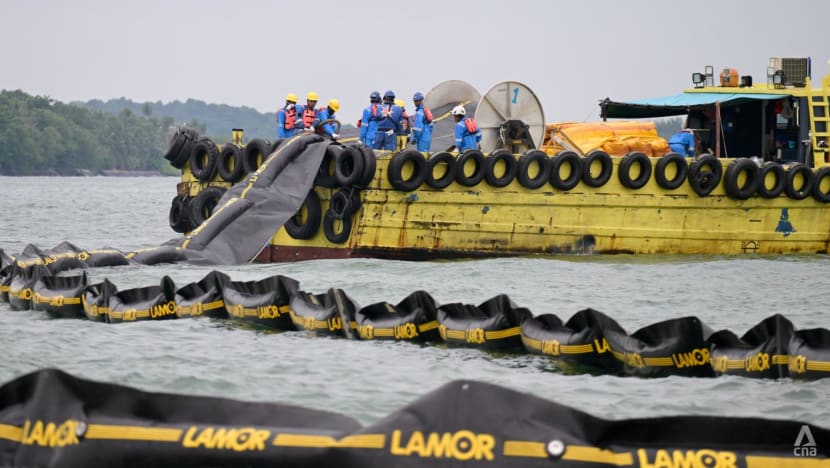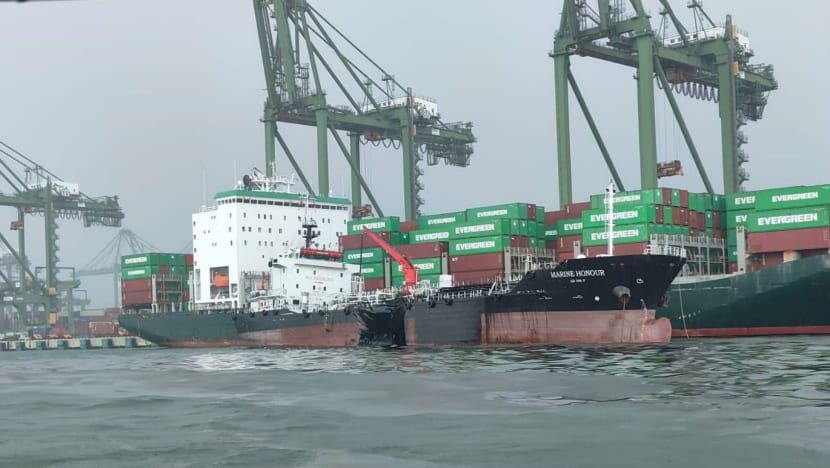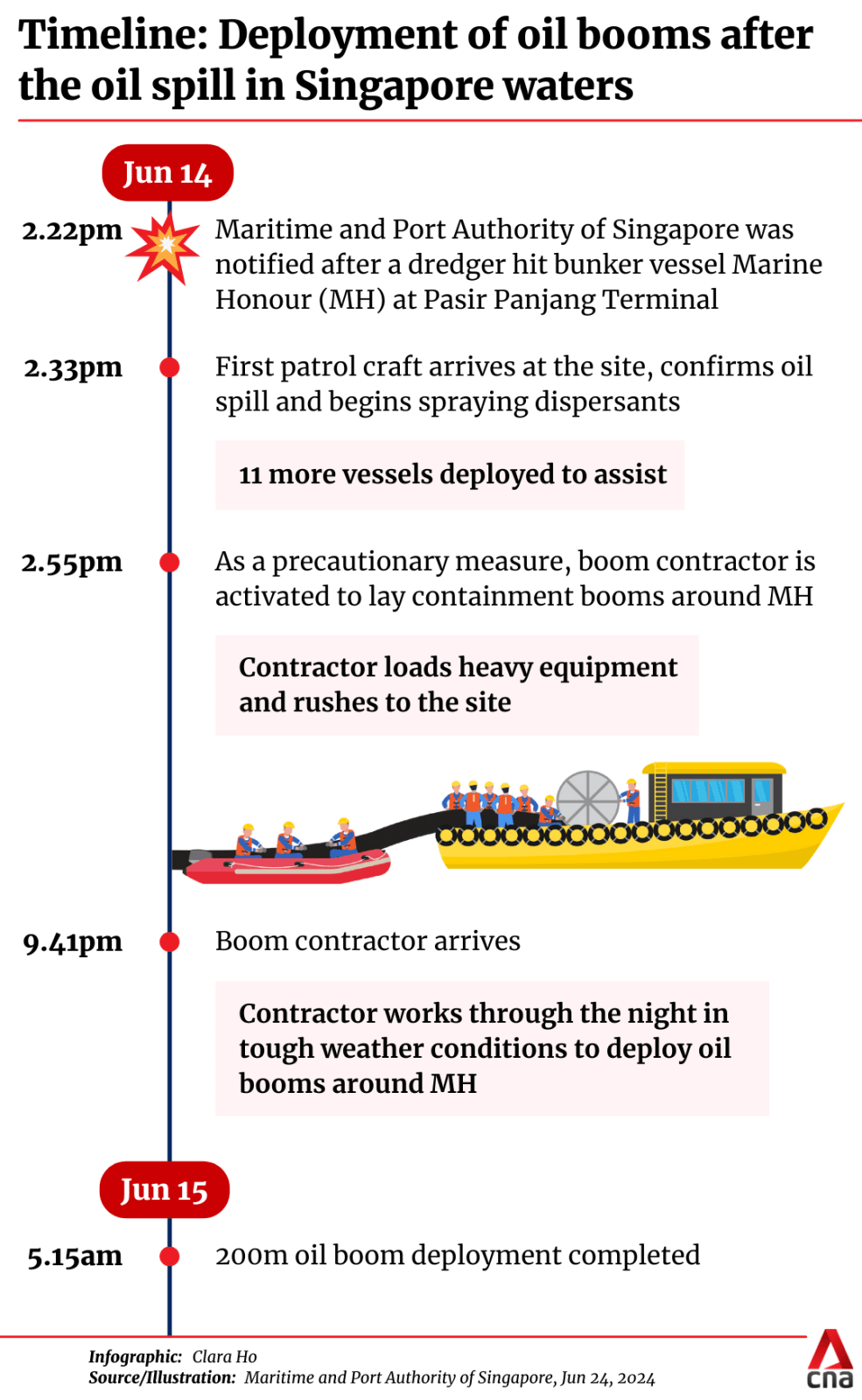Timeline of Singapore's oil spill: When response teams mobilised, booms deployed

Workers from T&T Salvage Asia deploying oil booms into areas affected by the oil spill. (Photo: CNA/Marcus Mark Ramos)

This audio is generated by an AI tool.
SINGAPORE: The removal of bulk oil from the sea and Singapore's beaches is nearly completed, with about 550 tonnes of oil-soaked sand and debris collected from all affected beaches, authorities said on Monday (Jun 24).
A dredger hit a bunker vessel at Pasir Panjang Terminal on Jun 14, causing oil to spill into the water. In the aftermath of the incident, oil slicks were spotted at several beaches around Singapore.
Hundreds of workers have been involved in the clean-up efforts, with the bulk of oil-soaked sand removed from most of the affected beaches, except Tanjong and Palawan beaches at Sentosa.
In a press conference on Monday as well, Transport Minister Chee Hong Tat gave a timeline of the authorities' response immediately after the oil spill.
He said the response times were "in line with international industry practices for responses to oil spills".
JUN 14
2.22pm: The Maritime and Port Authority (MPA) were informed that Netherlands-flagged dredger Vox Maxima had hit a stationary bunker vessel Marine Honour at Pasir Panjang Terminal.
2.33pm: MPA's first patrol craft arrives at the incident site. It sprayed dispersant on the observed oil sheens to treat the oil.
The dispersant is used to break down the oil, which will facilitate subsequent clean-up operations at sea and land. Without the dispersant, it would have hardened over time and become more difficult to remove.
Eleven more vessels from MPA and its contractors were deployed to assist in the response, including spraying dispersants or monitoring for oil slicks in the water.
Mr Chee said that MPA focused on the safety of the damaged vessel to confirm that it would not sink and conducted checks to ensure that the crew were safe and the spillage was under control.
There was also no further spillage after the initial gush, which released an estimated 400 tonnes of oil into the sea.

2.55pm: MPA activated T&T Salvage Asia - a salvage and marine firefighting service provider - whose staff contacted their boss, Captain Anuj Sahai to lay containment booms around the damaged vessel.
T&T needed a few hours to load the heavy equipment on its vessel and for its workboats to get to the incident site.
Other agencies, such as the National Environment Agency and Sentosa Development Corporation (SDC), were also informed of the oil spill on the day of the incident and they actively monitored the waters and the developing situation.
9.20pm: SDC began to cordon off affected parts of Palawan beach when oil sheens were first sighted.
9.41pm: T&T’s vessel arrived at the incident location.
JUN 15
5.15am: Deployment of oil booms at the incident site was completed.
Mr Chee said T&T did well to deploy 200m of oil booms around the damaged vessel by working through the night, despite the bad weather conditions.
He added that the purpose of the containment booms around the damaged vessel was not to “fence in” the oil that had been spilt, but as a preventive measure in case there was further spillage from the damaged vessel.
The boom can help to catch some oil spill in the vicinity but it is not "100 per cent foolproof, because the tidal currents and waves can carry the oil to go below or above the booms".
7am: Oil slicks were spotted in waters at Palawan, Siloso and Tanjong beaches at Sentosa. SDC deployed workers to start the clean-up.
NEA also mobilised its personnel and public cleaning service providers to carry out clean-up operations at East Coast Park, Labrador Nature Reserve and Tanah Merah beach.

Minister for Sustainability and the Environment Grace Fu said on Monday that clean-up operations are expected to take around three months before affected areas such as beaches are progressively reopened to the public.
"The first phase of the clean-up focused on removing the oil slicks and contaminated sand from the surface of the affected beaches and deploying booms to avoid further contamination," she said.
"This is making good progress and approaching completion."
The next phase will be "more complex in nature" and focus on difficult-to-clean areas like rock bunds, breakwaters, and oil trapped deeper in the sand. That is expected to take about three months.
A final phase of cleaning will see beaches combed to remove "tar balls" – small blobs of coagulated oil in the sand.
















